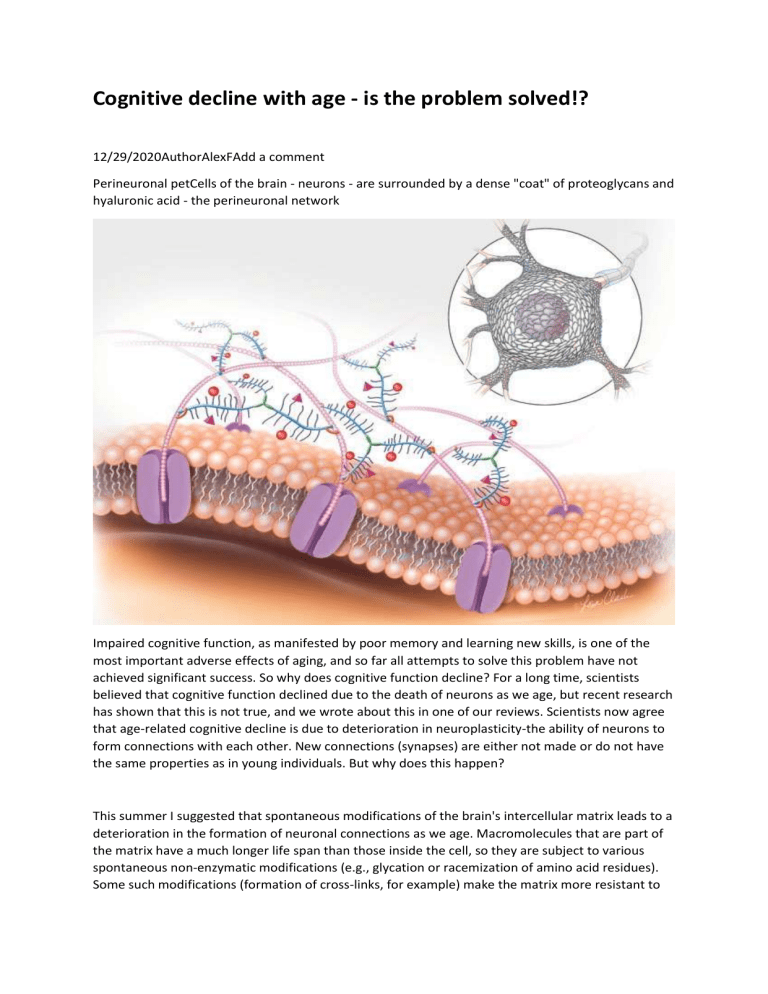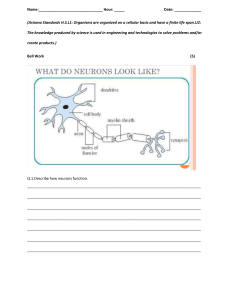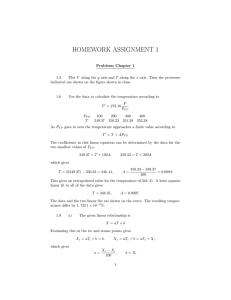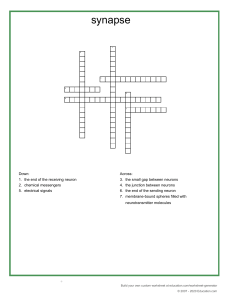
Cognitive decline with age - is the problem solved!? 12/29/2020AuthorAlexFAdd a comment Perineuronal petCells of the brain - neurons - are surrounded by a dense "coat" of proteoglycans and hyaluronic acid - the perineuronal network Impaired cognitive function, as manifested by poor memory and learning new skills, is one of the most important adverse effects of aging, and so far all attempts to solve this problem have not achieved significant success. So why does cognitive function decline? For a long time, scientists believed that cognitive function declined due to the death of neurons as we age, but recent research has shown that this is not true, and we wrote about this in one of our reviews. Scientists now agree that age-related cognitive decline is due to deterioration in neuroplasticity-the ability of neurons to form connections with each other. New connections (synapses) are either not made or do not have the same properties as in young individuals. But why does this happen? This summer I suggested that spontaneous modifications of the brain's intercellular matrix leads to a deterioration in the formation of neuronal connections as we age. Macromolecules that are part of the matrix have a much longer life span than those inside the cell, so they are subject to various spontaneous non-enzymatic modifications (e.g., glycation or racemization of amino acid residues). Some such modifications (formation of cross-links, for example) make the matrix more resistant to degradation by special enzymes, and degradation of the brain matrix is a necessary step in formation of a synapse (connection between neurons), because in order to form a connection, one first has to clear a space for it in the wilds of the matrix (see figure). And so, conducting a search, I found a number of studies that not only support the hypothesis, but directly say that the culprit of brain aging is the intercellular matrix, or rather, its special kind called perineuronal net. This is a kind of "coat" or "armour" (depending on one's preference) that surrounds neurons and plays a crucial role in memory formation and other brain functions. It was discovered at whom the famous cell organelle was named). Below are images of what this very perineuronal the very end of the 19th century by the famous Italian scientist Camillo Golgi (the same Golgi after network looks like. . Back in 2017 (or maybe earlier), scientists became interested in the role of perineuronal networks in brain aging. Indeed, by that time a lot of evidence had accumulated about their crucial role in cognitive processes. And Simona Foscarin et al. drew attention to such an important aspect as sulfation of chondroitin, which is a part of perineuronal networks. It sounds scary at first glance, but in general there is nothing complicated: sulfation is simply the addition of sulfur (or rather, sulfogroups) to one of the sugars that make up the long chain of chondroitin. C4S and C6S disaccharides that make up chondroitin. Chondroitin, or more specifically chondroitin sulfate, is made up of many of these disaccharides The sulfogroup can be linked to a carbon atom in the 4th or 6th position (as seen in the figure above). It would seem that the difference is negligible; the untrained eye would not even immediately notice the difference between these two disaccharides. However, in reality, the roles of C4S and C6S are opposite! C6S promotes the formation of connections between neurons, while C4S, on the contrary, prevents them. Guess which chondroitin decreases with age? That's right, the amount of C6S decreases and this supposedly leads to memory and learning problems. An important point the authors found: the expression of genes that carry sulfur (sulfogroup) does not change with age! This means that a decrease in C6S can occur spontaneously, non-enzymatic, although the authors themselves think that there is a slight change in expression, just the sensitivity of the method does not allow it to be detected. However, this is just an association, a connection. And this connection may not be causal at all (as often happens in science). And scientists already have something to respond to this counterargument: destruction of perineuronal networks by the enzyme chondroitinase improved memory in adult model animals! Yes, yes, the poor animals were injected directly into their brains! And it bloody well improved their memory. For eight weeks, really. So wait, don't reach for the drill and the long needle (we know you biohackers). In fact, there's another potential pitfall with this approach: the authors of this scientific paper hypothesize that the degradation products of perineuronal networks may contribute to the pathogenesis of Alzheimer's disease. Their hypothesis fits nicely into a single picture: Perineuronal network degradation products may be part of amyloid plaques and also activate microglia, which may contribute to Alzheimer's disease There is another way: In a 2020 preprint, the authors used an adeno-associated viral vector to deliver extra copies of the 6-sulfotransferase gene, an enzyme that attaches a sulfogroup to the 6th carbon atom in a sugar that is part of chondroitin. And it also restored memory to the old mice. Looks like we can't do without injections to the brain after all... In conclusion, the brain intercellular matrix and perineuronal networks are going to be a very hot topic in the next few years. For example, there is a hypothesis that very long-lasting memories are stored in the patterns of holes of perineuronal networks (wait for chondroitinase injections in the brain). I think we are in for a lot of interesting discoveries when biologists finally shift the focus from cells to what these cells are in. Alexander Fedintsev was with you, register on our site to receive regular updates and have access to closed materials. Have a good long-term memory in the New Year!




